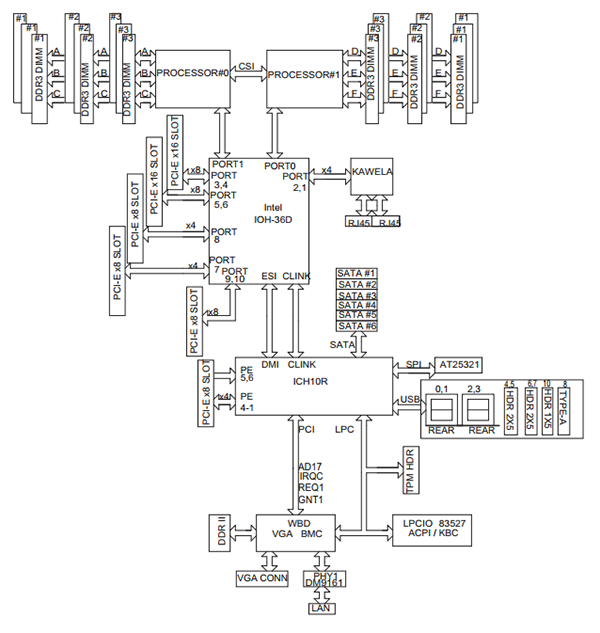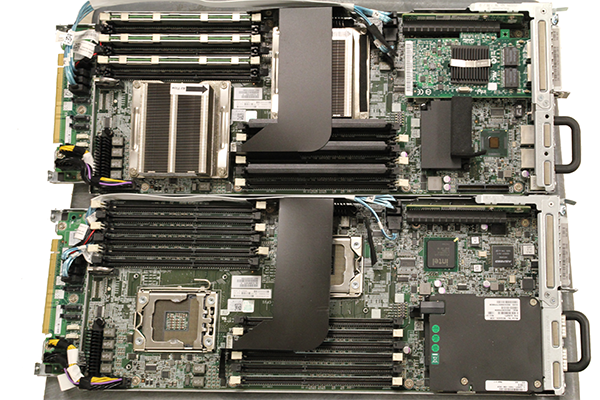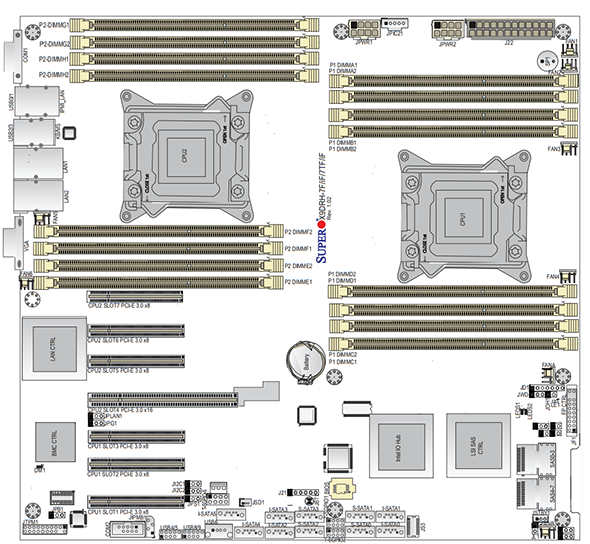One question we get asked at least one time each week is whether or dual socket motherboards meant for dual processors can work with one CPU. A common driver behind this question is because dual processor motherboards allow for easy expansion at a later date. Add a second CPU, heatsink/ fan and additional memory to a system without replacing any internal components or adding a second machine. The answer to the question “Can I use one CPU in a dual processor motherboard?” is yes… with some caveats. Let’s explore why.
The vast majority of motherboards “just work” if you install a CPU into the lowest numbered CPU slot. This is usually CPU0 if there is CPU0 and CPU1 or CPU1 if the board is tagged CPU1 and CPU2. This is true for both Intel and AMD motherboards in general and when in doubt, most motherboard manuals will instruct a user as to which processor slot can be populated by a single CPU and a dual CPU motherboard. Here is an example from a Supermicro X8DTN motherboard that was a fairly popular dual processor Intel 5500 and 5600 series Xeon motherboard.

Since the Intel 5500 and 5520 series chipset had an IOH northbridge, populating only one CPU slot in the dual socket motherboard did not cut out any additional motherboard resources. In the Intel socket LGA1366 days, and with the AMD C32 and G34 platforms, both the northbridge and southbridge were found on the motherboard so the CPUs generally connected through the northbridge to get to an expansion card bus. In these systems, the main impact of only having one CPU (other than the obvious loss in CPU performance without the second CPU) is that one could not populate the memory banks for the empty processor slot. This is very similar to the single CPU nodes we use for the STH colocation project, even though each Dell C6100 node is dual processor capable.

Underneath those heatsinks on the upper node sits only one processor despite the board being dual-processor capable. One can also see that the associated DRAM bank is filled with DDR3 RDIMMs while the empty socket is utilizing DIMM blanks. This setup is much different than a more modern LGA2011 dual Intel Xeon motherboard. Here is an example of a Supermicro X9DRH-7TF which has both onboard LSI SAS and Intel X540 10GbE:

Today’s architectures add another level of complexity. With the dual Intel Xeon E5 LGA2011 platform as an example, the PCIe expansion slots are directly tied to a CPU. On the picture above, one can see each PCIe slot tied to a specific CPU. When a CPU socket is not populated, the PCIe lanes do not terminate. This has a major impact on the functionality of the motherboard. For example, if the second CPU socket is not filled in a dual socket motherboard oftentimes onboard devices such as Ethernet and SAS controllers may not work. Furthermore, PCIe lanes may not work. This will render the slots useless until the additional CPU(s) are added. Here is an associated diagram for the Supermicro X9DRH-7TF:

Here we can see that if CPU1 was missing, the onboard Intel X540 10GbE LAN and LSI SAS2208 controller do not have a PCIe but to hang off of. Conversely, with no CPU2, one would not have access to several PCIe 3.0 x8 slots. Luckily, most motherboard manufacturers state in their manuals which socket to populate.
Any further questions feel free to ask in the forums!





This was helpful. Might get a dual socket motherboard instead of a single next time then upgrade when chips get less expensive.
keep in mind the dl370 g7 has two IOH like the dl380p G8 (but not the dl360G8). If you have good numa locality (esxi/sql os soft-numa) you essentially have two computers with two iohub’s.
Otherwise you have two cpu’s fighting over one set of cards. In real life what I have witnessed with LSI controllers and ssd is that having a single socket performs far better than two with one IOHUB. I suspect this is why they threw a second IOHUB on the dl380p gen8.
I suspect the AMD solutions (4-way) having 4 bus verus the DL580 having 2 bus is a huge advantage.
Just have to mind your wide vm’s or setup numa locality properly.
This is very much why many folks have dual 6-core servers with 20% utilization. 32 pci lanes to split up to both sockets isn’t going to cut it.
The dl380p gen8 has 80 lanes (40 per cpu) with the dual IOH setup. 10gb nic eats up 8 lanes with pci-e 2.0. 6 ssd’s in raid eat up 8 lanes in pci-e 2.0.
It doesn’t take a rocket scientist to figure out that having 1 bus per socket with high bandwidth setups (10gb, ssd) you are wasting a cpu.
HPC users will not have a problem as long as they manage numa locality.
Unfortunately linux/freebsd have some pretty bad numa management and you can get into severe thrashing if you are not careful. (this may have changed it’s been a few years since i’ve used mysql in a numa setup).
If you have dual IOHUB motherboard, you will want to balance your resources (one nic per iohub, one raid per iohub) so that the QPI bus is not flooded – iirc the IOHUB’s are even interconnected with a QPI link but I am not sure it all worked out so hot with 5520 chipset.
Kind of a stupid question but if I installed Ubutnu when I had both processors in, is it possible to remove one of the processors and the server still function fine?
It should be fine. Depending on the processor you may lose PCIe lanes, DIMM slots and of course CPU cores. If you need any of that functionality, then that is where you will run into issues. But from an OS perspective, Ubuntu will be fine if you just remove a CPU and RAM.
I have bought supermicro H8DGU-F 2U MB for AMD Opteron processor.
The issue is I have damaged CPU1 socket in the MB as the pins are broken, but the CPU2 socket is intact.
The question is can i still use CPU2 alone and run my system. I have looked into the circuit diagram of my MB and as it looks CPU2 is not dependent on CPU1 but when i tried to assemble, the MB power light doesnt light up which is on the MB itself.
Please suggest a resolution…
So in theory this would work with a quad CPU board?
If I run four cpus and have dual boot. One being windows server to utilize all four and windows 7 or 10 to utilize just two cpus.
Would there be any conflict in running windows 7 which only recognizes two cpus while the other two (all four) are installed. Besides the fact that the cpus not being used and there associated ports ect not being accessible?
thanks for the information
I too use a single xeon e5503 cpu on dual socket motherboard but why I’m not seeing all cores of cpu in bios settings also i have opened msconfig there two cores were seen i selected it but system was slow as in msconfig option the ram was automatically selected to low and now im not able to see that any suggestions
Did anyone try this with the Gigabyte MZ72-HB0? :)
@phil Gigabyte MZ72-HB0 that’s the question I need answering..